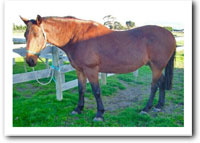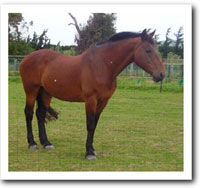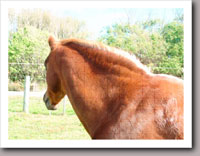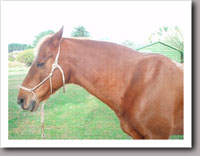Laminitis or Founder
If your horse has foundered first call a vet immediately for pain relief and then read here for managing the foundered horse. Foundering is an extremely painful condition and should NEVER be taken lightly.
About Laminitis/Founder...
There are several potential causes of laminitis:
- Any major infection such as a retained placenta
- Some medications
- Any injury which causes constant weight-bearing on the other ‘good’ limb
- Standing on poisonous substances
- Gorging on grain from the feed bin
- Fructans in cool season grasses like rye-grass
The sort of laminitis we are talking about here is that which is most common, especially in spring and autumn, and is caused by the mineral imbalances inherent in the grass the horse is consuming, referred to here as ‘Grass-Induced laminitis’.
Sugars & Mineral Imbalances
If we confine our thinking to the sugar content of the forage alone as a cause of metabolic syndrome and laminitis then there is no explanation for why horses (& ponies) on very well managed, low carbohydrate diets still get laminitis.
On inspection of their living area the short, green grass is visible.
Nibbling around on these tips of fresh spring or autumn growth or the tips of any grass after rain will bring on an attack of laminitis in susceptible animals.
If they do not have access to any green grass at all they do not get the bouts of laminitis from this particular cause.
Preventing laminitis is well recognised to be a case of good diet and plenty of exercise. Whilst exercise alone will not prevent laminitis happening to susceptible horses and ponies eating the ‘wrong grass’, the right diet and pasture management will, without any exercise. Of course it is Ideal that they have both a good diet and plenty of exercise.
After the horse has recovered, access to grass needs to be for limited periods of the day on the most mature grass possible. People say ‘he’s only allowed on grass for a few hours a day’ but they are not aware their horse can eat a colossal amount of grass in an hour, let alone 3-4 hours or a whole day!
Diligence is needed to avoid them eating grass that is stressed or at the wrong stage of growth. Their staple diet needs to consist of suitable meadow hay, not fresh, green hay and definitely no clover or lucerne*.
*Lucerne is often advocated as a suitable feed for laminitic horses and ponies on the basis that it has a lower NCS content. However because it is a very high potassium/low sodium forage it is totally unsuitable.
(Read about Lucerne here)
Longer grass is safer from the point of view of mineral balances but becomes higher in sugars as it grows, especially the cool season grasses like rye-grass. It is still not possible to leave horses out 24/7 on this longer grass because they will eat far too much of it. If it is sweet they will literally gorge themselves on it, then they will ingest too much potassium, sugars and protein.
Horses are designed to extract a little bit of nutrition out of a constant trickle of low quality feed which over 18-20 hours a day add up to a large quantity.
Modern, so-called ‘improved’ pastures and most hard-feeds do exactly the opposite, they supply a lot of nutrition in a small quantity of feed. This does not suit horses who are supposed to nibble and chew all day.
The feeding of a daily feed that includes minerals essential for the prevention of metabolic disorders will give you more insurance against any relapses.
Fructans
When conditions are not optimal for growth, cool season grasses store their sugars as indigestible ‘fructans’ (which are chains of sugar molecules joined together). No mammals have the enzymes to break down and utilise fructans.
Fructans which are consumed and eventually do arrive in the hind-gut of the horse or pony can only be fermented by the Streptococcus bacteria. This bacteria, normally only present in small numbers now have the opportunity for a feast enabling a population explosion, thereby disturbing the balance of the healthy gut flora. This starts a cascade of problems which can precede a bout of laminitis (Dr Chris Pollitt).
The ‘fructans’ factor is just one of the many reasons that rye-grass and clover are completely unsuitable as forage for horses and ponies.
More about Rye & Clover here
The Difference between
‘Laminitis’ & ‘Founder’
Whilst Dimples recently suffered from Laminitis, she did not actually ‘founder’. (see Dimple's Laminitis)
Laminitis is an inflammatory bio-chemistry problem which can be relatively easily corrected whereas ‘founder’ is a mechanical breakdown of hoof tissue which takes a LOT LONGER to heal.
To ‘founder’ means to ‘sink’. When a horse has foundered, it means that the laminae (which hold knits the inside of the hoof wall, onto the outside of the coffin bone) have ‘let go’ and the coffin bone therefore sinks within the hoof capsule.
This is way worse than a laminitic episode and should be avoided at ALL COSTS because recovery takes months if not a whole year with a lot of intensive care whilst the new hoof capsule grows down with new laminar connection.
If action isn’t taken immediately the coffin bone can protrude through the sole.
Many people think this is the end of the road but they sure can come back from this, while this takes place, the bone column needs to be supported and there are other options to the heart-bar shoe –
see Peppy’s story
Signs that the coffin bone has sunk include
- The sole becomes convex instead of concave
- The horse is in extreme pain
- Exhibits rocked back stance
- The hair around the coronet sticks up and there is a dip around the coronet area.
If we had not acted immediately with the diet changes, Dimple’s laminitis could have easily progressed to founder.
*If your horse has foundered immediate veterinary attention is required for serious ongoing pain relief.
Founder does not happen overnight – if your horse has actually ‘foundered’ then you have missed some pretty obvious signs or you have been given some very wrong advice
Take Action!
Take Action to Prevent Grass Induced Laminitis
Jenny Paterson B.Sc
Laminitis can happen at any time of the year but more so in early spring and Autumn. When the autumn rains come, horses and ponies will get laminitis all over the place because their owners are unaware that the change in the grass which accompanies those autumn rains is dangerous to prone animals.
There are several different causes of laminitis but the most prevalent is that which is caused by the grass at these times. Wild horses in a desert environment, with little or no access to green grass do not get laminitis from this cause, whereas laminitis is very common in horses kept behind fences and forced to eat the regrowth. This is the real source of the trouble!
These same steps apply if your horse already has ‘sore feet’. If your horse has got to the stage where he is rocked back on his heels or lying down, then urgently call your vet for assessment and pain relief.
Remember that horses and ponies are ‘silent sufferers’. It is not uncommon for them to be seen out in the paddock, having hardly moved for several days, just shifting their weight from foot to foot or rocking back on their heels in the typical laminitis stance, sweating with the pain and the owner hasn’t even noticed that there is anything wrong!
Horses and ponies that are not necessarily obese but who show the signs of Insulin resistance are equally as prone to bouts of laminitis.
Signs that your horse is suffering from Mineral Imbalances and is prone to laminitis...
- May or may not be obese. May or may not be an ‘easy keeper’
- You can see evidence of abnormal fat deposits on the crest of the neck, behind the shoulders, on the tail-head and even on the sides of the rump
- Puffy around the eyes and sheath
- Bloodshot eyes
They can exhibit all the above signs for long periods and not develop laminitis.

Click here to Read bout this horse's recovery.

What is it about the Grass?
In spring and autumn, grass undergoes rapid growth spurts for which it requires potassium and nitrogen. Under conditions right for growth the grass tips rapidly become high in potassium but not correspondingly high in sodium. This floods the horses system with potassium upsetting the delicate sodium:potassium ratio which the body tries so hard to maintain.
Grass in spring and autumn also becomes high in nitrates (protein precursor). Excess nitrates are attached to calcium and magnesium and excreted via the gut and the urine, rapidly depleting the horse of these other vital electrolytes.
This serious electrolyte imbalance (that of excess potassium relative to sodium, chloride, calcium and magnesium) has multiple consequences, one of them being that of inflammation of the musculature as in Jane's horse , of the trigeminal nerve as in head-flicking horses such as Ted and of the laminae as in laminitis.
It is no coincidence that all of these scenarios are triggered seasonally under the same weather conditions. They all happen on the same day, so to speak.
Causes of Inflammation:
Toxins, allergies, autoimmune diseases, infections, acid-base disorders, injury, and free radical damage can trigger or cause inflammation.
Acid-base disorders are deviations from the normal body pH and these are caused by the electrolyte imbalances. For instance constant chloride depletion from high potassium/sodium chloride depleted diets can cause a rise in body pH (alkalosis) which leads to inflammation, instability of cell membranes and inappropriate firing of nerves
Feeding to Prevent Metabolic Syndrome and Laminitis
The quickest recovery from laminitis that I and others have observed is when all green is immediately and thoroughly removed from the diet. This includes the most microscopic green shoots coming thru the dirt. You can cover them up with sand or bark.
'Restricting' the grass, mowing, putting other stock through first; none of these cut the mustard. The slightest green tinge can perpetuate this painful condition.
They must go into some kind of a ‘dry lot’. This may be a large yard, round pen, arena, or a track.
Read Keeping Horses on Dry lots/Tracks
When you take a horse or pony off the grass you must make sure they never run out of food by supplying adlib hay. This is where the Hay-Saver Nets become invaluable as they slow the eating process down and ensure there is a constant trickle of coarse, fibrous material going thru the digestive system, thereby keeping the horse contented and healthy.
The emphasis to date has always been to ‘cut down the sugars’, or the carbohydrate portion of the horse’s diet. This is still important but equally, if not more important, are the mineral balances. Nutrition for these horses and ponies should include a daily feed such as soaked beet with linseed or Zeaola meal and oil for Omega 3’s, into which is mixed their salt and Premium NZ Horse Minerals (Supreme vits & mins in Australia).
Do I Need to Soak the Hay?
Soaking reduces the NSC (Non-structural carbohydrate, or sugar) content of the hay by 30% and the potassium content by 50% (www.safergrass.org)
If your horse or pony is obese then soaking the hay will speed up weight loss. You will soon get into a routine especially if you locate your drum for soaking near the tap or hose.
Put the hay into your Hay-Saver first, then immerse the whole bag in the tub of water for at least an hour.
Some horses may object to the sugarless hay at first, just persevere. Some get where they actually prefer it.
Do not soak oaten or lucerne hay. There have been some very bad reactions apparently caused by the nitrogen component converting to ammonia.

‘Spitfire’ Before dietary changes and after...

What about Sugars in the Grass?
If we confine our thinking to the sugar content of the forage alone as a cause of metabolic syndrome and laminitis then there is no explanation for why horses & ponies on very well managed, low carbohydrate diets still get laminitis. Take the case of ‘Georgia’ for example.
The quickest recovery from sore feet (laminitis) is achieved when ALL GREEN is immediately and thoroughly removed from the diet. This includes the most microscopic green shoots coming thru the dirt. You need to be ‘on patrol’ for these and cover them up with salt, sand or bark.
Merely restricting access to grass, mowing, putting other stock through first; none of these strategies cut the mustard. The slightest green tinge can perpetuate this painful condition.
They need to go into some kind of a ‘dry lot’. This may be a large yard, round pen, arena, or a track.
When you take a horse or pony off the grass you must make sure they never run out of food by supplying adlib hay. Hay-nets with the small mesh are invaluable as they slow the eating process down and ensure there is a constant trickle of coarse, fibrous material going thru the digestive system.
During this recovery time their diet needs to consist of suitable meadow hay, not fresh, green hay and definitely no clover or lucerne. (Lucerne is often advocated as a suitable feed for laminitic horses and ponies on the basis that it has lower sugar content. However because it is a very high potassium/low sodium forage we have found it to be totally unsuitable)
After the horse has recovered, access to grass needs to be gradually introduced for very limited periods of the day on the most mature grass possible. People completely underestimate how much grass a horse can consume in a short time let alone 3-4 hours or a whole day! Start with no more than 10 minutes!
Diligence is needed to avoid them eating grass that is stressed or short, green and growing to prevent a relapse to which they will be very susceptible.
How Laminitis Episodes Happen ...
Lots of rain followed by hot dry days creates the ideal conditions for laminitis. Very potent grass shoots and clover spring out of the ground overnight.
Many people are caught unaware, hence here is a list of scenarios which lead to laminitis episodes.
I need to emphasise that we too have made many of these fatal mistakes over the years, suffering the painful learn curve before bit by bit learning how to be proactive and work on PREVENTION:
Avoid these common errors of thinking:
• Thinking that any grass is good grass for horses and having no idea about the effect that changes (in the grass) have on the horse
- Not understanding that ‘all grass is not equal’, that it varies from property to property and its nutrition profile depends on many factors from the soil to the season and the weather
• Not regularly eliminating legumes like Lucerne and clover broadleafs like plantain
• Grazing on dairy pasture or applying inappropriate fertilsers
• Overgrazing so the grass is short all the time, thinking horses on ‘Jenny Craig’ paddocks will lose weight.
• Not having access to dry lot options to enable the customizing of grass intake according to needs (this could be because you rent grazing)
• Focusing solely on SUGARS in the grass instead of ALSO addressing MINERAL IMBALANCES which involves being mindful of potassium intake, adding salt to feeds rather than relying on salt licks
• Relying on an ‘app’ to tell you if the grass is safe or not – by the time the app is telling you the grass is dangerous it may already be too late
• Going on holiday and leaving in charge someone else who feels sorry for your horse in his ‘dry lot’ and lets him out on the grass
• Meaning to leave him out for half an hour but when sidetracked with something else, he ends up being out for several hours (we hear this scenario a lot)
• Failing to understand how incredibly quickly laminitis can happen! (overnight in some cases)
• Missing the warning signs (walking stiffly/slowly, blood in the white line (laminae), tender footed on hard ground, crest of neck goes rock hard) and not getting them off the grass soon enough.
• Being pulled in different directions by conflicting information
• Not having any kind of pasture management strategy for long term, eg keeping longer more mature grass to give your horse appropriate access to
• Irrigating the short grass to keep it green
• Confining horses and ponies in little yards or paddocks – horses need a lot of movement
• A hard trim – we all tend to trust our farriers and hoof trimmers, however it is unbelievable how many times a horse is put in even more pain because he was trimmed too hard, before, during or after a laminitic episode. See last point, these horses need the fastest hoof wall growth possible
• Not appreciating how easily stressed horses are especially if they are already compromised with health issues. Leaving them on their own, or without forage is enough to trigger stress, raise cortisol levels and precipitate a laminitic episode.
• It is vital to feed Minerals, Vitamins and Amino acids to horses with laminitis to facilitate REPAIR of the damaged tissue and promote new hoof growth. These are non-calorie nutrients without sugars or potassium.

*The hooves in the pictures belong to a pony who had serious laminitis.
The ‘before’ picture was taken when he first came under our care, he was very sore.
The ‘after’ picture shows his hooves now.
This is a comparison of his overall condition which, as you see was poor when he arrived...

He has been fed the MVA for about 6 months.
Here he is in January 2018 – completely sound on very hard ground!

 Calm Healthy Horses
Calm Healthy Horses